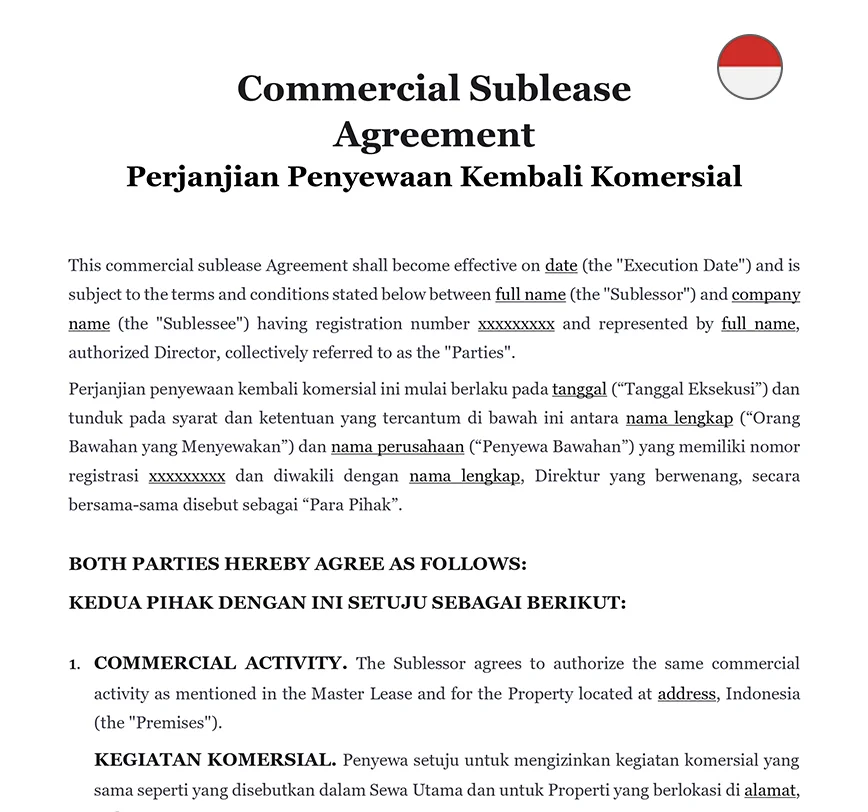Transferring rental rights for commercial properties
Transferring rental rights for commercial properties is a significant process that can offer flexibility and financial benefits for both tenants and landlords. Whether you’re looking to sublease part of your space or transfer your lease entirely, understanding the legal and practical aspects is crucial. A well-drafted agreement protects all parties involved and ensures a smooth transition.
In this guide, we’ll cover the essential steps and considerations for transferring rental rights. If you’re looking for a hassle-free way to draft a sublease agreement, our comprehensive commercial sublease agreement template can help you avoid common pitfalls and ensure legal compliance. Explore our professional templates and legal services to make the transfer process seamless and secure.
ℹ️ For subletting personnal spaces like appartments, consider using our sublease agreement drafted by lawyers
Understanding Rental Rights Transfer
Transferring rental rights for commercial properties involves passing your lease obligations and privileges to another party. This process can take two primary forms: subleasing and lease assignment. Knowing the difference between these two is vital for making informed decisions that suit your situation and goals.
1.Definition and Types
Subleasing :
Subleasing occurs when the original tenant (the sublessor) rents out part or all of the leased property to a new tenant (the sublessee) while retaining some lease responsibilities. The sublessor remains liable to the landlord for the rent and any damages caused by the sublessee. This arrangement is often used when the original tenant needs temporary relief from rent obligations without permanently giving up the lease.
Lease Assignment:
In a lease assignment, the original tenant transfers all their lease obligations and rights to a new tenant (the assignee). The original tenant typically exits the lease entirely, and the assignee assumes full responsibility to the landlord. This option is suitable when the original tenant no longer requires the space and wishes to transfer the lease completely.
2. Legal Considerations
Key Legal Aspects:
Before transferring rental rights, it is crucial to understand the legal implications. The terms of the original lease agreement often dictate what is permissible regarding subleasing and assignment. Some leases may prohibit these actions outright, while others may require landlord approval.
Compliance with Local Laws:
Different regions have specific laws governing rental rights transfers. Ensure you are aware of local regulations to avoid potential legal issues. Consulting a legal professional can provide clarity and help you navigate these complexities.
Key Elements to Transfer rental rights for commercial properties
A well-drafted sublease agreement is essential for protecting the interests of all parties involved. Below are the key elements that should be included in any comprehensive sublease agreement to ensure clarity and legal compliance.
| ➤ Identifying the Parties Involved: Clearly state the names and contact details of the original tenant (sublessor), the new tenant (sublessee), and the landlord. This ensures that all parties are correctly identified and can be contacted if necessary. |
| ➤ Description of the Premises: Provide a detailed description of the property being subleased, including its address, unit number, and any specific areas included in the sublease. This helps to prevent any misunderstandings about which part of the property is being rented. |
| ➤ Term of the Sublease: Specify the duration of the sublease, including the start and end dates. Clearly defining the sublease term helps in planning and ensures both parties are aware of the rental period. |
| ➤ Rent Payment Details: Outline the rent amount, due dates, and payment methods. Include any late fees or penalties for missed payments to avoid disputes over financial matters. |
| ➤ Maintenance and Repairs: Define the subtenant’s responsibilities regarding the maintenance and repair of the property. This should include who to contact for repairs and who bears the cost of such maintenance. |
| ➤ Termination Conditions: Describe the conditions under which the sublease can be terminated by either party. Include the notice period required and any penalties for early termination to provide clear guidelines for ending the agreement. |
Common Mistakes to Avoid
When transferring rental rights for commercial properties, avoiding common pitfalls is crucial to ensure a smooth and legally compliant process. Here are some frequent mistakes to watch out for:
1.Overlooking Lease Terms
Failing to review and adhere to the original lease terms can lead to legal complications and disputes. Ensure that the sublease or assignment complies with the conditions set forth in the initial lease agreement.
2.Inadequate Documentation
Not having a well-drafted sublease agreement can result in misunderstandings and conflicts between parties. A comprehensive and legally binding document is essential for protecting all parties involved.
3.Failing to Obtain Consent
Neglecting to secure written consent from the landlord can render the sublease or assignment invalid and may result in legal repercussions. Always obtain formal approval to avoid potential issues.
Avoiding these common mistakes will help ensure a successful and legally sound transfer of rental rights. For more detailed guidance on avoiding pitfalls in rental agreements, check out our guide on “Avoiding Common Mistakes in Rental Contracts in Indonesia.” This resource can help you navigate complex rental agreements and safeguard your investment.
ℹ️ For additional peace of mind, use our professional consent to sublease template to ensure all legal requirements are met and your interests are protected
Ask your question and receive legal advice from a qualified lawyer
310 client reviews (4.8/5) ⭐⭐⭐⭐⭐











